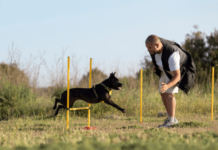Last Updated on August 27, 2022 by Dogs Vets
Is a Golden Retriever Easy to Train?
Is a golden retriever easy to train? The answer to this question depends largely on the breed of your golden retriever.
Although some females are better-suited for training, there are some key differences between male and female golden retrievers.
This article will provide you with some helpful tips on how to train a female.
A female golden retriever is an excellent pupil and social butterfly and is easy to train. Listed below are some tips on training a female.
Female golden retriever is easier to train
Compared to their male counterparts, female Golden Retrievers are much easier to train. The females are more focused and less prone to run off. This is why it is better to start training a female puppy early in its life.
Females also show less stubbornness and more personality.
Listed below are some reasons why a female is easier to train than a male:
Unlike males, female golden retrievers are more independent, confident, and tolerant around children. While they may not be as affectionate as their male counterparts, they are much better around young children and do not need as much attention.
Although they can be stubborn and need a lot of attention, a female is more likely to please you and will respond more quickly. It is therefore recommended to start training a female golden retriever early so she can become well-behaved as she grows older.
Female golden retriever is well-suited to learning
A Golden Retriever is a highly trainable breed. As such, it’s easy to learn new tricks and habits with the help of a dog training book. The breed was bred to please its owners. Here are some tips to get the most out of your Golden.
You can also teach your Golden to obey you. A dog that knows a command is a joy to own. Listed below are some tips on how to train your Golden.
View this post on Instagram
A Golden Retriever has moderate energy and must get plenty of exercise. This breed is often a great companion for children and fragile adults. Be sure to supervise your Golden’s behavior around small children and other animals.
It’s important to teach this breed how to greet people with respect. They’re also prone to misbehaving, so proper training is essential. But even with the right approach, it’s easy to train your golden to be good at fetching.
Female golden retriever is a social butterfly
A golden retriever is a sociable and social creature who thrives in any environment.
This breed is known for its ability to make friends with anyone and is an excellent companion for children. They are active, playful, and do well with children and active families. They are also a great fit for homes with other pets, but would be equally happy as the only dog.
However, if you want to make sure your new pup gets along with other animals, they may not be the best fit.
Border Collies are extremely social dogs, but can get into trouble with new people. These dogs are generally not a good choice for households that are a chaotic mess.
The Border Collies, on the other hand, are very social and enjoy meeting new people.
Although these dogs can get along with other dogs, they may feel out of place in a busy environment. Therefore, it is crucial to socialize your dog from a young age.
Female golden retriever is a good pupil
If you want a well-behaved dog, consider a female Golden Retriever. The female has a smoother coat and may appear feathered on the body.
Males, on the other hand, have thicker coats and tend to be more playful. Both sexes are easy to train.
A positive reinforcement method will ensure your golden retriever learns to respect your authority and learn to behave accordingly.
The female Golden Retriever’s pupils function like a camera shutter, dilating or constricting depending on the distance to the focus.
An abnormally fixed pupil could be an indication of a problem in the dog’s brain. Similarly, dilated pupils in both eyes is called mydriasis.
Different-sized pupils are called anisocoria. A female golden retriever with fixed pupils is not a good candidate for breeding.
Female golden retriever has personality quirks
Golden retrievers are a popular breed for people who want a family dog that is gentle, obedient, and intelligent. Because of their gentle nature and playful, receptive personalities, they make great pets and are perfect for families.
Despite their playful nature, goldens tend to be quite docile and do not have many personality quirks, though they can get a little bit too spoiled with affection.
Although there is no set rule on how a female Golden Retriever will act or behave, there are some common traits that make her unique.
Females are less mischievous than males, and they mark their territory more often. They also pee more often.
The traits outlined below may not apply to all Golden Retrievers, however, so be sure to ask your breeder about her own personality quirks and how you can best respond to them.
Facts Check:
We hope you enjoyed this amazing article… What are your thoughts about When Should I Start Training a Dog?
Feels free to share this article!
We make it our mission to give animal lovers the most up-to-date and accurate information possible while maintaining our commitment to justice.
Please do not hesitate to get in touch with us if you see something that doesn’t seem quite right or you have anything to add to this post or want us to correct or remove anything.
If you are interested in advertising with us. Please get in touch with us!

















